 |
|
https://edibleplants.org/ |
 |
| https://edibleplants.org/ |
Translate this page:
Summary
Pacaya Palm, Chamaedorea tepejilote, is a small palm tree from the Arecaceae family found in southern Mexico, Central America, and northern Colombia where it is considered to be an important vegetable crop and an ornamental. It is usually single-stemmed and grows up to 7 m in height and 10 cm in trunk diameter. The trunk has swollen nodes and the crown is composed of loose dark green fronds. The flowers are fragrant, greenish-yellow in colour, and form into clusters just below the crown. Pacaya palm is dioecious and fast-growing. It can be solitary or clumping. The immature, male inflorescence is eaten raw or cooked as vegetable and added to salads. The leaves and apical buds can also be cooked.
Physical Characteristics

 Chamaedorea tepejilote is an evergreen Tree growing to 7 m (23ft) by 5 m (16ft) at a fast rate.
Chamaedorea tepejilote is an evergreen Tree growing to 7 m (23ft) by 5 m (16ft) at a fast rate.
See above for USDA hardiness. It is hardy to UK zone 10. The plant is not self-fertile.
Suitable for: light (sandy), medium (loamy) and heavy (clay) soils and prefers well-drained soil. Suitable pH: mildly acid, neutral and basic (mildly alkaline) soils. It can grow in full shade (deep woodland) or semi-shade (light woodland). It prefers moist soil.
UK Hardiness Map
US Hardiness Map
Synonyms
Chamaedorea anomospadix Burret Chamaedorea casperiana Klotzsch Chamaedorea columbica Burret Chamaedo
Plant Habitats
Edible Uses
Edible Parts: Flowers Leaves
Edible Uses:
Edible portion: Cabbage, Palm heart, Male flower, Bracts. The immature, male inflorescence is eaten raw or cooked[ 301 , 314 , 423 ]. The male flower is eaten while immature in salads. It is also boiled or fried in egg batter. It is harvested before the inflorescence opens, at which stage it looks like an ear of corn[ 423 ]. Added to salads ( traditionally eaten in Guatemala on the Day of the Dead) or cooked as a vegetable (called "rellenos de pacaya," and is often served with tomato sauce, like chiles rellenos.) [ 297 , 301 ]. A bitter flavour, it is sometimes cooked in several changes of water[ 301 ]. Leaves - cooked[ 763 ]. The apical bud, often known as a 'palm heart', is eaten as a vegetable[ 763 ]. Eating this bud leades to the death of the tree because it is unable to make any side shoots[ K ].
References More on Edible Uses
Medicinal Uses
Plants For A Future can not take any responsibility for any adverse effects from the use of plants. Always seek advice from a professional before using a plant medicinally.
None known
References More on Medicinal Uses
The Bookshop: Edible Plant Books
Our Latest books on Perennial Plants For Food Forests and Permaculture Gardens in paperback or digital formats.

Edible Tropical Plants
Food Forest Plants for Hotter Conditions: 250+ Plants For Tropical Food Forests & Permaculture Gardens.
More

Edible Temperate Plants
Plants for Your Food Forest: 500 Plants for Temperate Food Forests & Permaculture Gardens.
More

More Books
PFAF have eight books available in paperback and digital formats. Browse the shop for more information.
Shop Now
Other Uses
References More on Other Uses
Cultivation details
A plant of the moist tropics, where it is found at elevations up to 1,600 metres. It grows best in areas where annual daytime temperatures are within the range 20° - 28°c, but can tolerate 15° - 32°c[ 418 ]. It can be killed by temperatures of 2°c or lower[ 418 ]. Plants can tolerate occasional light frosts[ 423 ]. It prefers a mean annual rainfall in the range 1,000 - 2,500mm, but tolerates 700 - 3,000mm[ 418 ]. An easily grown plant if its basic requirements are met[ 297 ]. It requires at least moderate shade, and can tolerate deep shade[ 297 ]. It requires a well-drained, moist, humus-rich soil[ 297 , 314 ]. Prefers a pH in the range 6.5 - 7.5, tolerating 6 - 8[ 418 ]. A variable plant in the wild, with some forms growing 7 metres or more tall and others only 2 metres[ 297 ]. A fast-growing plant, producing flowers and fruit when only a few years old[ 297 ]. A dioecious species - both male and female forms need to be grown if fruit and seed are required[ 297 , 768 ].
References Carbon Farming Information and Carbon Sequestration Information
Temperature Converter
Type a value in the Celsius field to convert the value to Fahrenheit:
Fahrenheit:
The PFAF Bookshop
Plants For A Future have a number of books available in paperback and digital form. Book titles include Edible Plants, Edible Perennials, Edible Trees,Edible Shrubs, Woodland Gardening, and Temperate Food Forest Plants. Our new book is Food Forest Plants For Hotter Conditions (Tropical and Sub-Tropical).
Shop Now
Plant Propagation
Plants are grown from seed.
Other Names
If available other names are mentioned here
Pacaya Palm, Chamaedorea tepejilote, Other Names: Cana verde, Pacaito, Siplina.
Native Range
NORTHERN AMERICA: Mexico (Chiapas, Oaxaca, Veracruz de Ignacio de la Llave) SOUTHERN AMERICA: Belize, Costa Rica, Guatemala, Honduras, Nicaragua, Panama, El Salvador, Colombia (Chocó, Valle del Cauca)
Weed Potential
Right plant wrong place. We are currently updating this section.
Please note that a plant may be invasive in one area but may not in your area so it's worth checking.
None Known
Conservation Status
IUCN Red List of Threatened Plants Status : This taxon has not yet been assessed.

Growth: S = slow M = medium F = fast. Soil: L = light (sandy) M = medium H = heavy (clay). pH: A = acid N = neutral B = basic (alkaline). Shade: F = full shade S = semi-shade N = no shade. Moisture: D = dry M = Moist We = wet Wa = water.
Now available:
Food Forest Plants for Mediterranean Conditions
350+ Perennial Plants For Mediterranean and Drier Food Forests and Permaculture Gardens.
[Paperback and eBook]
This is the third in Plants For A Future's series of plant guides for food forests tailored to
specific climate zones. Following volumes on temperate and tropical ecosystems, this book focuses
on species suited to Mediterranean conditions—regions with hot, dry summers and cool, wet winters,
often facing the added challenge of climate change.
Read More
Expert comment
Author
Leibm. ex C.Mart.
Botanical References
Links / References
For a list of references used on this page please go here
A special thanks to Ken Fern for some of the information used on this page.
Readers comment
| Add a comment |
|
If you have important information about this plant that may help other users please add a comment or link below. Only comments or links that are felt to be directly relevant to a plant will be included. If you think a comment/link or information contained on this page is inaccurate or misleading we would welcome your feedback at [email protected]. If you have questions about a plant please use the Forum on this website as we do not have the resources to answer questions ourselves.
* Please note: the comments by website users are not necessarily those held by PFAF and may give misleading or inaccurate information.
To leave a comment please Register or login here All comments need to be approved so will not appear immediately.
|
Subject : Chamaedorea tepejilote
|
|
|
|